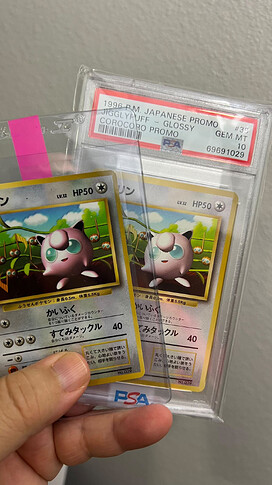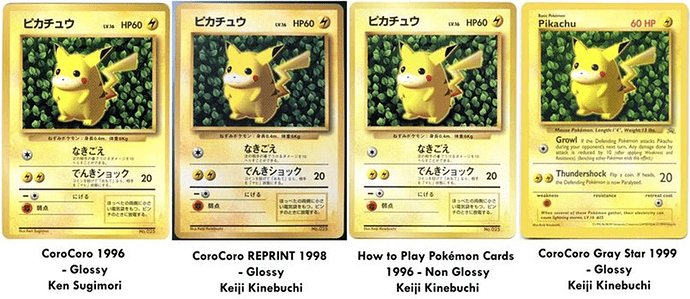The first ever Pokémon TCG cards released to the public were the 1996 Glossy Ivy Pikachu and glossy Jigglypuff. These 2 cards were released in Corocoro magazine on October 15, 1996 and predate the release of Japanese base set/no rarity by 5 days. (October 20, 1996).
An interesting tidbit about the Pikachu is that the 1996 glossy Ivy Pikachu is actually an “error card” as “Ken Sugimori” was mistakenly listed as the illustrator instead of the correct illustrator for these cards, “Keiji Kinebuchi.”
These cards are also extremely challenging to grade — the reason being is that they are on glossy card stock and also had to be “peeled” out from an appendix inside the corocoro comic, making many cards damaged upon peeling. These 2 promo cards are almost always notoriously off-centered.
These same 2 cards (Ivy PIkachu and Jigglypuff) were reprinted as non-glossy cards 2 months later as part of a promo with “Asobikata Magazine Vol 1” and the “Ken Sugimori” error was fixed on the Ivy Pikachu — making the 1996 Ivy glossy Pikachu easily distinguishable from the non-glossy version.
The Jigglypuff however is much more challenging to distinguish between glossy vs. non-glossy.
For both of these promo cards, the non-glossy versions are roughly 10x-100x easier to grade as well because of non-glossy card stock, better centering, and no common edge damage from peeling from the corocoro comic.
My question to E4 and the Pokémon community: Do any PSA 10’s actually exist of the first ever released Pokemon TCG cards?
Upon further investigation I have found that every single PSA 10 card graded of these 2 cards (that I’ve been able to find photos existing online) are mislabeled. More below.
Here are 3 mislabels of the Ivy glossy Pikachu. These are clearly mislabels as you can see “Keiji Kinebuchi” is listed as the illustrator on these 3 cards. The first printing of this card had “Ken Sugimori” incorrectly printed as the illustrator, so this is an easy mislabel to spot.
The Jigglypuff is much more challenging to identify (Glossy vs. Non-glossy) unless you are holding these cards in your hand and able to see glossy vs. non glossy, However, there are some noticeable difference that you can still get clues of identifying glossy vs. non-glossy with the jigglypuffs.
I created a guide for PSA to be able to differentiate.
(Above) True glossy Jigglypuff card vs. a non-glossy mislabeled PSA 10. It is much easier to see when they are right next to one another.
What do you all think? Are there any true PSA 10’s out there or is every single PSA 10 on the population report a “mislabel”?





